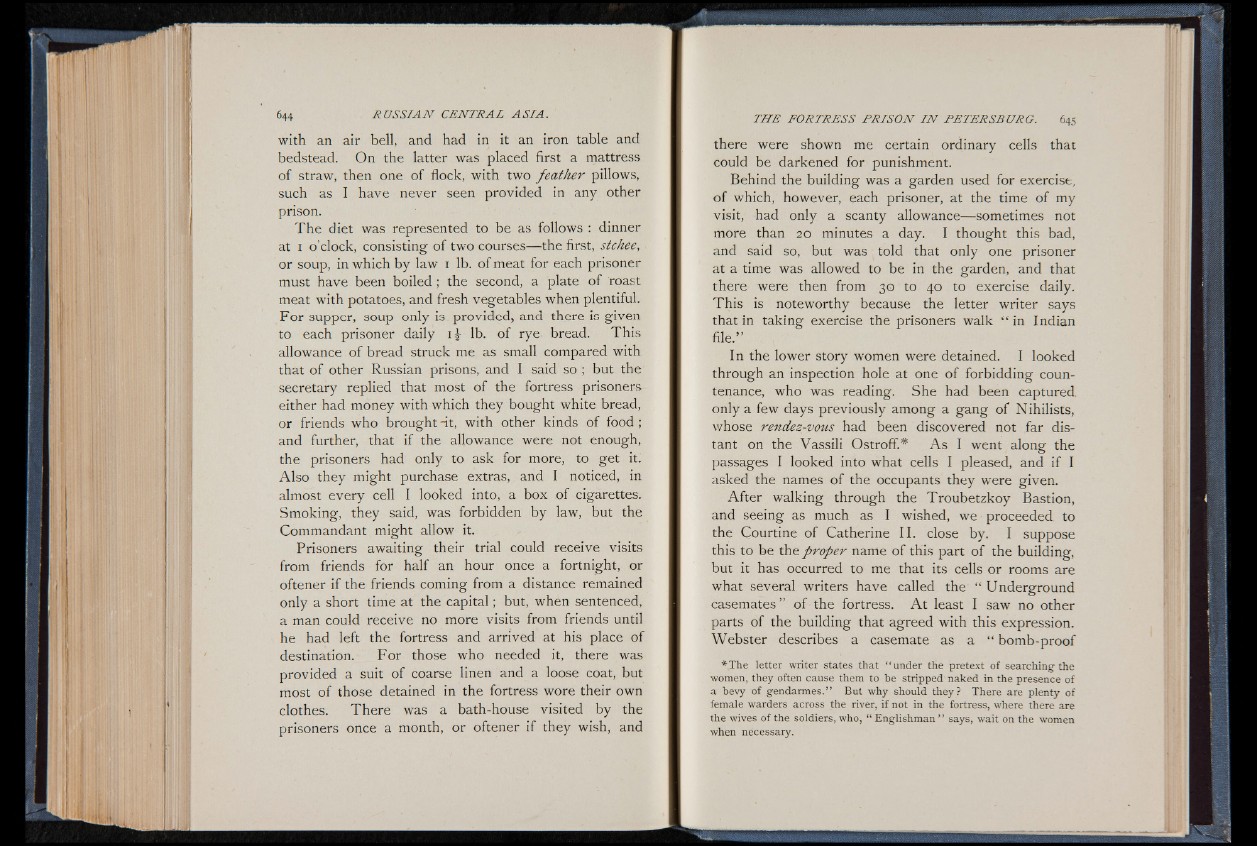
with an air bell, and had in it an iron table and
bedstead. On the latter was placed first a mattress
of straw, then one of flock, with two feather pillows,
such as I have never seen provided in any other
prison.
The diet was represented to be as follows : dinner
at i o’clock, consisting of two courses— the first, stchee,
or soup, in which by law i lb. of meat for each prisoner
must have been boiled ; the second, a plate of roast
meat with potatoes, and fresh vegetables when plentiful.
For supper, soup only is provided, and there is given
to each prisoner daily i j lb. of rye- bread. This
allowance of bread struck me as small compared with
that of other Russian prisons, and I said so ; but the
secretary replied that most of the fortress prisoners
either had money with which they bought white bread,
or friends who brought -it, with other kinds of food ;
and further, that if the allowance were not enough,
the prisoners had only to ask for more, to get it.
Also they might purchase extras, and I noticed, in
almost every cell I looked into, a box of cigarettes.
Smoking, they said, was forbidden by law, but the
Commandant might allow it.
Prisoners awaiting their trial could receive visits
from friends for half an hour once a fortnight, or
oftener if the friends coming from a distance remained
only a short time at the capital; but, when sentenced,
a man could receive no more visits from friends until
he had left the fortress and arrived at his place of
destination. For those who needed it, there was
provided a suit of coarse linen and a loose coat, but
most of those detained in the fortress wore their own
clothes. There was a bath-house visited by the
prisoners once a month, or oftener if they wish, and
there were shown me certain ordinary cells that
could be darkened for punishment.
Behind the building was a garden used for exercise,
of which, however, each prisoner, at the time of my
visit, had only a scanty allowance— sometimes not
more than 20 minutes a day. I thought this bad,
and said so, but was told that only one prisoner
at a time was allowed to be in the garden, and that
there were then from 30 to 40 to exercise daily.
This is noteworthy because the letter writer says
that in taking exercise the prisoners walk “ in Indian
file.”
In the lower story women were detained. I looked
through an inspection hole at one of forbidding countenance,
who was reading. She had been captured,
only a few days previously among a gang o f N ihilists,
whose rendez-vous had been discovered not far distant
on the Vassili Ostroff.# As I went along the
passages I looked into what cells I pleased, and if I
asked the names of the occupants they were given.
After walking through the Troubetzkoy Bastion,
and seeing as much as I wished, we proceeded to
the Courtine of Catherine II. close by. I suppose
this to be the proper name of this part of the building,
but it has occurred to me that its cells or rooms are
what several writers have called the “ Underground
casemates ” of the fortress. A t least I saw no other
parts of the building that agreed with this expression.
Webster describes a casemate as a “ bomb-proof
*T h e letter writer states that “ under the pretext of searching-the
women, they often cause them to be stripped naked in the presence of
a bevy of gendarmes.” But why should they? There are plenty of
female warders across the river, if not in the fortress, where there are
the wives of the soldiers, who, “ Englishman ” says, wait on the women
when necessary.